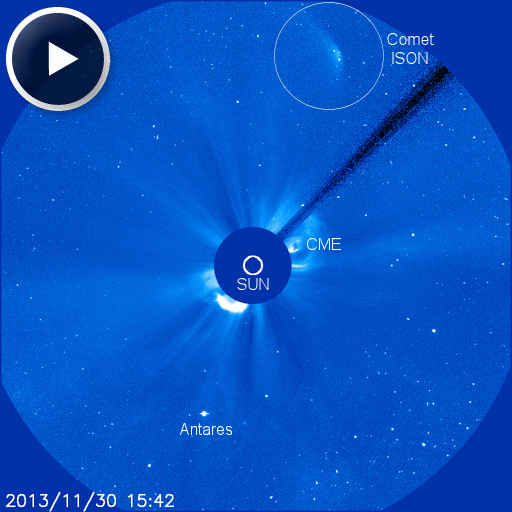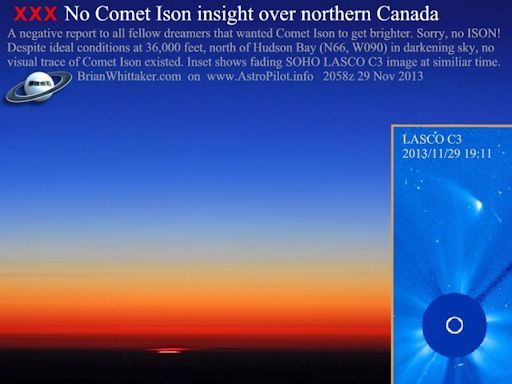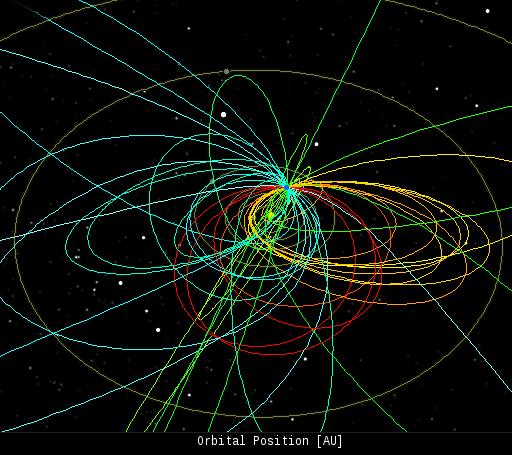When is the best time to see auroras? Where is the best place to go? And how do you photograph them? These questions and more are answered in a new book, Northern Lights - a Guide, by Pal Brekke & Fredrik Broms. | | | CHANCE OF FLARES: Earth-facing sunspots AR1907 and AR1908 have 'beta-gamma' magnetic fields that harbor energy for moderately strong flares. NOAA forecasters estimate a 25% chance of M-flares and a 5% chance of X-flares on Nov. 30th. Solar flare alerts: text, voice COMET ISON DIES ... AGAIN: Comet ISON is fading fast as it recedes from the sun. Whatever piece of the comet briefly survived its Thanksgiving Day brush with solar fire is now dissipating in a cloud of dust. Click to view a 3-day movie centered on perihelion (closest approach to the sun): 
This development makes it unlikely that Comet ISON will put on a good show after it exits the glare of the sun in early December. Experienced astrophotographers might be able to capture the comet's fading "ghost" in the pre-dawn sky, but a naked-eye spectacle is out of the question. On Nov. 29th, pilot Brian Whittaker tried to catch a first glimpse of Comet ISON from Earth, post-perihelion, from a plane flying 36,000 feet over the Arctic Circle in northern Canada. No luck: 
"Ideal viewing conditions from the Arctic revealed no Comet ISON," reports Whittaker. "This negative report is to quench the thirst of other fellow dreamers under cloudy skies or further south. Later I could see that SOHO showed the comet dimming further." Despite Whittaker's negative result, it is too soon to rule out observations from Earth as the twice-dead comet moves away from the glare of the sun. Meanwhile, NASA's fleet of solar observatory will be tracking the remains. Stay tuned for more images. Realtime Comet ISON Photo Gallery
Realtime Space Weather Photo Gallery
Realtime Aurora Photo Gallery
Every night, a network of NASA all-sky cameras scans the skies above the United States for meteoritic fireballs. Automated software maintained by NASA's Meteoroid Environment Office calculates their orbits, velocity, penetration depth in Earth's atmosphere and many other characteristics. Daily results are presented here on Spaceweather.com. On Nov. 30, 2013, the network reported 36 fireballs.
(35 sporadics, 1 November omega Oriond) 
In this diagram of the inner solar system, all of the fireball orbits intersect at a single point--Earth. The orbits are color-coded by velocity, from slow (red) to fast (blue). [Larger image] [movies] Potentially Hazardous Asteroids ( PHAs) are space rocks larger than approximately 100m that can come closer to Earth than 0.05 AU. None of the known PHAs is on a collision course with our planet, although astronomers are finding new ones all the time. On November 30, 2013 there were 1440 potentially hazardous asteroids. Notes: LD means "Lunar Distance." 1 LD = 384,401 km, the distance between Earth and the Moon. 1 LD also equals 0.00256 AU. MAG is the visual magnitude of the asteroid on the date of closest approach. | | The official U.S. government space weather bureau | | | The first place to look for information about sundogs, pillars, rainbows and related phenomena. | | | Researchers call it a "Hubble for the sun." SDO is the most advanced solar observatory ever. | | | 3D views of the sun from NASA's Solar and Terrestrial Relations Observatory | | | Realtime and archival images of the Sun from SOHO. | | | from the NOAA Space Environment Center | | | the underlying science of space weather | | 
